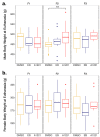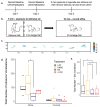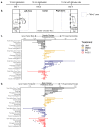Transgenerational Effects of Prenatal Endocrine Disruption on Reproductive and Sociosexual Behaviors in Sprague Dawley Male and Female Rats
- PMID: 35202233
- PMCID: PMC8875130
- DOI: 10.3390/toxics10020047
Transgenerational Effects of Prenatal Endocrine Disruption on Reproductive and Sociosexual Behaviors in Sprague Dawley Male and Female Rats
Abstract
Endocrine-disrupting chemicals (EDCs) lead to endocrine and neurobehavioral changes, particularly due to developmental exposures during gestation and early life. Moreover, intergenerational and transgenerational phenotypic changes may be induced by germline exposure (F2) and epigenetic germline transmission (F3) generation, respectively. Here, we assessed reproductive and sociosexual behavioral outcomes of prenatal Aroclor 1221 (A1221), a lightly chlorinated mix of PCBs known to have weakly estrogenic mechanisms of action; estradiol benzoate (EB), a positive control; or vehicle (3% DMSO in sesame oil) in F1-, F2-, and F3-generation male and female rats. Treatment with EDCs was given on embryonic day (E) 16 and 18, and F1 offspring monitored for development and adult behavior. F2 offspring were generated by breeding with untreated rats, phenotyping of F2s was performed in adulthood, and the F3 generation were similarly produced and phenotyped. Although no effects of treatment were found on F1 or F3 development and physiology, in the F2 generation, body weight in males and uterine weight in females were increased by A1221. Mating behavior results in F1 and F2 generations showed that F1 A1221 females had a longer latency to lordosis. In males, the F2 generation showed decreased mount frequency in the EB group. In the F3 generation, numbers of ultrasonic vocalizations were decreased by EB in males, and by EB and A1221 when the sexes were combined. Finally, partner preference tests in the F3 generation revealed that naïve females preferred F3-EB over untreated males, and that naïve males preferred untreated over F3-EB or F3-A1221 males. As a whole, these results show that each generation has a unique, sex-specific behavioral phenotype due to direct or ancestral EDC exposure.
Keywords: Aroclor 1221 (A1221); endocrine-disrupting chemical (EDC); estradiol; mating behavior; paced mating; polychlorinated biphenyl (PCB); social behavior; transgenerational; ultrasonic vocalization (USV).
Conflict of interest statement
The authors declare no conflict of interest. The funder had no role in the design of the study; in the collection, analyses, or interpretation of data; in the writing of the manuscript, or in the decision to publish the results.
Figures






Similar articles
-
Transgenerational effects of polychlorinated biphenyls: 1. Development and physiology across 3 generations of rats.Environ Health. 2018 Feb 20;17(1):18. doi: 10.1186/s12940-018-0362-5. Environ Health. 2018. PMID: 29458364 Free PMC article.
-
Transgenerational effects of polychlorinated biphenyls: 2. Hypothalamic gene expression in rats†.Biol Reprod. 2021 Sep 14;105(3):690-704. doi: 10.1093/biolre/ioab066. Biol Reprod. 2021. PMID: 33824955 Free PMC article.
-
Social and neuromolecular phenotypes are programmed by prenatal exposures to endocrine-disrupting chemicals.Mol Cell Endocrinol. 2019 Jan 5;479:133-146. doi: 10.1016/j.mce.2018.09.010. Epub 2018 Oct 1. Mol Cell Endocrinol. 2019. PMID: 30287398 Free PMC article.
-
Effects of the Endocrine-Disrupting Chemicals, Vinclozolin and Polychlorinated Biphenyls, on Physiological and Sociosexual Phenotypes in F2 Generation Sprague-Dawley Rats.Environ Health Perspect. 2018 Sep;126(9):97005. doi: 10.1289/EHP3550. Environ Health Perspect. 2018. PMID: 30212226 Free PMC article.
-
What is an epigenetic transgenerational phenotype? F3 or F2.Reprod Toxicol. 2008 Jan;25(1):2-6. doi: 10.1016/j.reprotox.2007.09.001. Epub 2007 Sep 11. Reprod Toxicol. 2008. PMID: 17949945 Free PMC article. Review.
Cited by
-
Paternal Western diet causes transgenerational increase in food consumption in Drosophila with parallel alterations in the offspring brain proteome and microRNAs.FASEB J. 2023 Jun;37(6):e22966. doi: 10.1096/fj.202300239RR. FASEB J. 2023. PMID: 37227156 Free PMC article.
-
Two Hits of EDCs Three Generations Apart: Evaluating Multigenerational Anxiety-Like Behavioral Phenotypes in Male Rats Exposed to Aroclor 1221 and Vinclozolin.Environ Health Perspect. 2024 Dec;132(12):127006. doi: 10.1289/EHP15684. Epub 2024 Dec 31. Environ Health Perspect. 2024. PMID: 39739410 Free PMC article.
-
Two Hits of EDCs Three Generations Apart: Evaluating Multigenerational Anxiety-Like Behavioral Phenotypes in Female Rats Exposed to Aroclor 1221 and Vinclozolin.Environ Health Perspect. 2024 Dec;132(12):127005. doi: 10.1289/EHP15621. Epub 2024 Dec 31. Environ Health Perspect. 2024. PMID: 39739409 Free PMC article.
-
A Protocol for the Non-invasive Method of Ultrasound Separation During the Sociosexual Vocal-Non-contact Model in Rats.Front Behav Neurosci. 2022 May 25;16:910591. doi: 10.3389/fnbeh.2022.910591. eCollection 2022. Front Behav Neurosci. 2022. PMID: 35692382 Free PMC article.
-
Microglial responses to inflammatory challenge in adult rats altered by developmental exposure to polychlorinated biphenyls in a sex-specific manner.Neurotoxicology. 2024 Sep;104:95-115. doi: 10.1016/j.neuro.2024.07.009. Epub 2024 Jul 20. Neurotoxicology. 2024. PMID: 39038526
References
-
- Zoeller R.T., Brown T.R., Doan L.L., Gore A.C., Skakkebaek N.E., Soto A.M., Woodruff T.J., Vom Saal F.S. Endocrine-Disrupting Chemicals and Public Health Protection: A Statement of Principles from The Endocrine Society. Endocrinology. 2012;153:4097–4110. doi: 10.1210/en.2012-1422. - DOI - PMC - PubMed
Grants and funding
LinkOut - more resources
Full Text Sources
Research Materials
Miscellaneous

